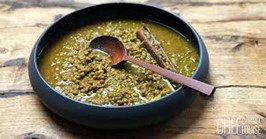Everyone is talking about fasting. There is so much (sometimes conflicting) information out there about fasting, what does Ayurveda have to say about it? And how can fasting be personalised to our individual constitutions?
Find all the answers to these questions here.
Ayurveda has a LOT to say about fasting – it’s a big part of Ayurvedic treatment
There are two main arms to Ayurvedic treatment, building someone up (brmhana) and reducing someone down (langhana).

Reducing treatment is needed when the body gets too heavy, too congested, has too much of the earth or water elements (e.g. kapha or sometimes pitta dosha) or has low digestive fire and āma (the sticky toxins lurking in the body which it cannot expel or use). Dosha in balance do not negatively affect health but when increased, can cause disease, as does āma.
Modern life produces huge need for reducing therapy and one of the most effective and easy methods is fasting (upavasa). Through fasting, we lighten the load on the digestive system and allow āma (sticky toxins) and excess dosha to be digested and various systems of the body to rest and repair.
Digestive fire cooks (digests) the food, in the absence of food, it cooks (digests) the dosha.[1]
A modern correlate to dosha can be senescent cells, those cells that produce inflammatory toxins. Yoshinori Ohsumi won the Nobel prize in 2016 for discovering the mechanism for the autophagy, the breakdown of such cells, and discovered that fasting encouraged this process. The more we can stimulate this process when needed by using methods such as fasting, the healthier we can be.
However, the above quote from Vagbhata in Astanga Hrdayam goes on to say:
When the dosha become decreased, the fire cooks the tissues and when the tissues become depleted, it cuts short the life itself.
Fasting is therefore a fabulous ‘reducing’ tool when needed but when overused, it can deplete us. We use it wisely.
Types of fasting in Ayurveda
There are degrees of fasting, some which may be more suitable for you than others. We can categorise fasting into three types: BARE MINIMUM, GENTLE and STRONGER. Let’s discover what is best for you.

BARE MINIMUM: Fasting until there is hunger
The bare minimum of fasting recommended for everyone apart from those who are severely depleted is to fast between meals until we experience proper hunger; that sensation of an empty stomach, a lightness to the body, clear burps and maybe a first rumble. This gives us a good length of time between meals for full digestion and assimilation and to maintain a well-functioning digestive fire.
The norm of eating in Ayurveda is 2 meals a day, the eating of which is recommended to be within a 6-hour window, one meal in the late morning/midday and one meal in the late afternoon/early evening. This means that for many of us there is a recommended 18 hour fasting window overnight. This can vary though; if you have a strong digestive fire and tend to stay at a lower weight, you will find your fasting window will be shorter than this. The important thing is that only YOUR BODY KNOWS, no-one else. If you follow your hunger, you will find your best rhythm.
GENTLE: Connecting with hunger AND eating lighter
Whilst sticking to the BARE MINIMUM fasting of only eating when properly hungry, we can make a stronger fast by eating lighter. Eating light can be eating lighter foods or less food or both. Favoured light and reducing foods are mung dal/soup, most other pulses, cooked green vegetables, buttermilk and spices. To make this an effective fasting method, spend a length of time only eating these light foods at the exclusion of all others, remembering to still only eat when hungry.
STRONGER: Longer stretches – fasting beyond hunger
This is taking fasting a step further, to not eating even when there is hunger. This is recommended when there is a clear need for reducing therapy (langhana) as discussed above (heaviness, congestion, too much earth/water/kapha, low digestive fire, presence of āma). Some of the specific conditions for fasting beyond hunger are obesity, fever, diarrhoea, nausea, vomiting, type 2 diabetes, and other kapha/pitta diseases.
You should NOT fast beyond hunger if you are emaciated, weak, have excess vata, are pregnant, are a child, are elderly or are in the grip of great fear, grief or anger.
This fast is kept until you have lightness in the body, signs of which are[2]:

We can supress hunger up and until these signs of reducing therapy completion but if we take it beyond that, we start to cause problems. We need to be vigilant; more isn’t always better! Signs you’ve gone too far are:

Fast beyond hunger if you need to do reducing therapy on yourself but stop when you feel the positive indications of successful reducing therapy and don’t reach the point of experiencing symptoms of overdoing it.
Using ghee to prolong the fast
When we fast for about 12 hours, our bodies move from sugar burning mode a fat burning mode (ketosis). We need to have regular access to both these modes as they have different benefits and disadvantages. By overriding hunger, we can prolong the time in fat burning mode. Another way to do this is to give the body only fats to digest when in this state so that our hunger dies down for a while, but we can continue to be in fat burning mode.
There is a treatment in Ayurveda which does just this, called snehapana[3] (literally ‘fat-drinking’). For this, when (and only when) hunger occurs in the morning, drink a volume of ghee (or sesame oil) and wait for hunger to return before eating food. Usually, the most we can stomach is 15-30ml (1 – 2 tbsp). Depending on your digestive capacity, this could give you 1 – 4 hours more time in fat-burning mode. If this suits you, you can do it again in the afternoon when you feel hungry. This snehapana practice is said to dispel all dosha, is particularly beneficial for those with skin diseases, gout, joint pain, obesity and high blood pressure and works at its best if you have taken digestive herbs for a few days beforehand.
Do not mix the oil with food but do have it with a drink such as warm water. If you find it unpalatable, a tip is to blend it thoroughly with a decaffeinated coffee[4], which makes it taste quite nice. Don’t eat to excess after digesting the oil and don’t exercise, have sex or sleep during the day that day.
There are three specifically named fasting lengths mentioned in the classical texts: 24 hour (mentioned in treatment for vata dominant fever), 48 hour (for pitta dominant fever) and 84 hour (for kapha dominant fever).
24 hour fast (1 day and 1 night)
An example of a 24 hour fast would be eating lunch one day and then nothing until eating lunch the next day. Charaka, one of the fathers of Ayurveda, says that eating only once in 24 hours is the best way to bring about happiness in your life[5]. If you are prone to āma or kapha accumulation or have low digestive fire, you could consider doing this weekly, being sure to enter and exit the fast with the right foods (see below). This is the longest someone with a vata constitution or imbalance should fast, and then only they are showing signs of needing reducing therapy (above).
32 hour fast (2 days and 1 night)
A 32 hour fast is when you fast after breakfast one day until the evening meal the next day. This is the longest someone with a pitta constitution or imbalance should fast.
72 hour fast (3 days and 3 nights)
This final type of fast is where you eat a meal and then nothing again until the same time in 3 days. For example, breakfast on Monday then just non-nutritive liquids until breakfast on Thursday. This is quite an extreme fast and great care needs to be taken to watch for signs of completion (above).
Personalised fasting for your constitution
As you have already seen, the type and length of fast you chose depends on what situation your body is in – it is not one size fits all.

How to start and end a fast
Ayurveda always takes the gentlest approach on the mind and body; it is not a system that advocates sudden changes as this provokes vata, a troublemaker. I would recommend entering and exiting a fast by going through each stage of fasting.
It is important to protect our digestive fire when fasting. You can imagine your digestive fire like a wood-fire. To get a good flame you need a delicate balance of enough fuel but not overloaded, enough air but not too much. When we fast, we stop adding more fuel which then gives the fire a chance to burn the fuel that is already there without being overloaded. The longer this continues, however, the lack of fuel starts to cause a lowering of the flame. In this way, the digestive fire after fasting can be delicate and we need to feed it properly when we start to eat again.

Fasting during your menstrual cycle
The menstrual cycle is divided into three stages dominated by the three dosha. Vata dominates during menstruation, kapha in the pre-ovulation proliferative phase and pitta in the post-ovulation secretory phase (see this article for more on this). Modern research on the effect of fasting on the hormones shows that stronger fasting is beneficial when oestrogen is low and needs producing but less beneficial when oestrogen is high, or progesterone production is needed. Modern proponents of fasts such as Dr Mindy Pelz[6], suggest stronger fasts for the first 10 days of the cycle and again just after ovulation for around 4 days and not at other times.
I judge the best time of the cycle to do STRONGER fasts (fasting beyond hunger) from an Ayurvedic perspective is during the kapha phase. Combining the ancient and modern wisdom on this suggests that a perfect time for STRONGER fasts is in the beginning of the kapha phase, directly after menstruation up until day 10. For example, if your menstruation lasts for 3 days, then you would be good to fast from day 4 – 10. If you bleed for 7 days, then it would be days 8-10. It is advised to eat lightly during menstruation itself so it would work well to do GENTLE fasting during menstruation and then STRONGER fasting straight afterwards. It is important to bear this in mind to enable good hormonal regulation.
Important takeaways (no, not that kind, even if you are now feeling peckish)
Keep an eye on how your body is feeling, when you start to feel heavy, sluggish, lacking in energy, weak in digestion and then pick a fast that suits you.
Seek help from a health professional if you are considering major changes to your diet and lifestyle, such as fasting.
Until next time, take care of yourself,
Kate
[1] Vagbhata’s Astanga Hrdayam Chikitsa Sthana 10/91
[2] Charaka Samhita Sutra Sthana 22/34-37
[3] Shamana snehapana – Astanga Hrdayam Sutra Sthana 16/19
[4] Only use coffee decaffeinated using the Carbon Dioxide or Swiss Water method.
[5] Charaka Samhita Sutra Sthana 25/40
[6] Fast like a Girl, Dr Mindy Pelz







0 Comments